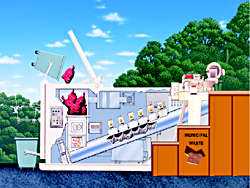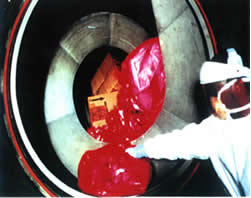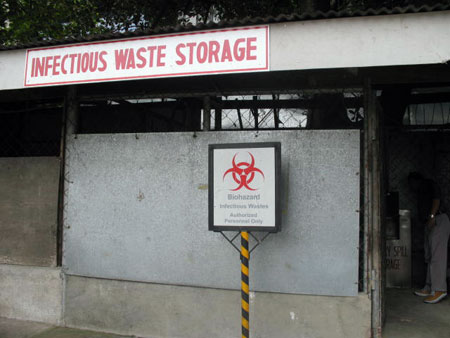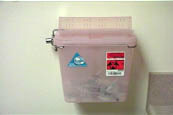HOSPITAL WASTE MANAGEMENT
-
Hospital waste is “Any waste which is generated in the diagnosis, treatment or immunization of human beings or animals or in research” in a hospital.
- Hospital Waste Management means the management of waste produced by hospitals using such techniques that will help to check the spread of diseases through
Hospital Waste categories and Disposal
|
Option |
Waste Category |
Treatment & Disposal |
|---|---|---|
|
Category 1 |
Human anatomical waste |
Incineration /deep burial |
|
Category 2 |
Animal waste |
Incineration /deep burial |
|
Category 3 |
Microbiology & biotechnology waste |
Incineration /deep burial |
|
Category 4 |
Sharps |
Incineration / disinfection /chemical treatment /mutilation |
|
Category 5 |
Medicines and cytotoxic drugs |
Incineration / destruction and disposal in secured landfill |
|
Category 6 |
Solid waste (Blood and Body fluids) |
Autoclave/chemical treatment/burial |
|
Category 7 |
Solid waste (disposable items) |
Autoclave/chemical treatment/burial |
|
Category 8 |
Liquid waste ( blood & body fluids) |
Disinfection by chemicals/discharge into drains |
|
Category 9 |
Incineration Ash |
Disposal in municipal landfill |
|
Category 10 |
Chemical waste |
Chemical treatment/ secure landfill |
![]()
WHO Medical Waste Categories
Infectious
Materials containing pathogens if exposed can cause disease.
- Human anatomical waste: waste from surgery and autopsies on patients with infectious diseases;
- Sharps: disposable needles, syringes, saws, blades, broken glasses, nails or any other item that could cause a cut;
- Pathological: tissues, organs, body parts, human flesh, fetuses, blood and body fluids;
Non Infectious (Hazardous) 
- Pharmaceuticals: drugs and chemicals that are returned from wards, spilled, outdated, contaminated, or are no longer required;
- Radioactive: solids, liquids and gaseous waste contaminated with radioactive substances used in diagnosis and treatment of diseases like toxic goiter.
Non Infectious (Non Hazardous)
- Domestic waste: from the offices, kitchens, rooms, including bed linen, utensils, paper, etc.
Hospital waste management programme
- Identification of waste types
- Segregation of waste
- Transport & storage of waste
- Proper disposal of waste
- Implementation of contingency plans
- Identify the need for use of personal protective equipment
Segregation by color coding system
Three categories
- Infectious waste – Red bags
- Domestic waste – Green Bags
- Sharps – Needle cutters / Puncture proof containers
- Segregation at Source ( ward, operation theater, laboratory, labour room, other places)
Transportation
- Containers: puncture proof, leak proof,
- Bags: sturdy, properly tied
- Transport trolleys: designated & timely
- Staff protection: provided with protective clothing and other items
- Never put hands in a bag
Waste storage
- Closed covered area
- Away from the normal passages
- Easily accessible for transportation
- Radioactive waste special containers/ special treatment and disposal
Proper disposal of waste
- All infectious waste and sharps containers :Incineration
- All Domestic waste : Landfill
- All hazardous waste : Chemical treatment before disposal
Implementation of contingency plans
- Contingency plans have to be in place to be implemented whenever any of the steps in the chain breaks and everyone should be aware of their responsibilities in case of breakdown.
Identify the need for use of personal protective equipment
- Special clothing, gloves, masks and eye protection should be identified and provided to the healthcare workers responsible for waste transportation and disposal.
